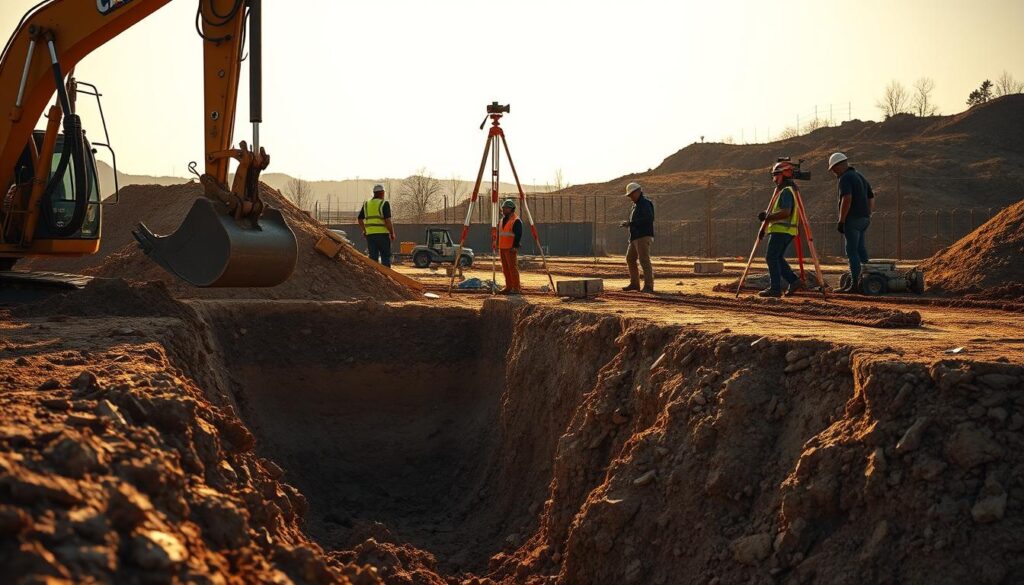Did you know that nearly 80% of construction projects encounter unforeseen subsurface issues, leading to costly delays and repairs? A thorough subsurface investigation is crucial in mitigating these risks.
A geotechnical site investigation provides vital information about the subsurface conditions, enabling engineers to design safe and stable structures. By understanding the soil and rock properties, engineers can predict potential hazards and develop effective solutions.
This process is essential for ensuring the success of construction projects, from foundations to tunnels and beyond.
Key Takeaways
- Critical role of subsurface investigation in construction projects
- Importance of understanding subsurface conditions for safe design
- Role of geotechnical site investigation in mitigating risks
- Benefits of thorough site characterization
- Impact on project success and cost savings
What is Geotechnical Site Investigation?
The process of geotechnical site investigation involves a comprehensive assessment of the soil and rock beneath a proposed construction site. This critical step helps in understanding the subsurface conditions that could impact the safety, stability, and cost-effectiveness of a project.
Geotechnical site investigations are designed to provide detailed information about the physical properties of the soil and rock, including their strength, density, and other characteristics. By doing so, these investigations enable engineers to make informed decisions about the design and construction of the project.
Definition and Purpose
A geotechnical site investigation is defined as the process of assessing the subsurface conditions at a site to determine its suitability for the intended structure. The primary purpose of such investigations is to identify potential geotechnical hazards and develop strategies to mitigate them, ensuring the project’s success.
The investigation process typically involves a combination of fieldwork, such as drilling and sampling, and laboratory testing to analyze the collected samples. For more information on the role of geotechnical engineers in conducting these investigations, you can visit World Civil Society.
By understanding the geotechnical aspects of a site, engineers can design structures that are not only safe and stable but also cost-effective. This is achieved through site characterization, which involves interpreting the data collected during the investigation to predict how the soil and rock will behave under different conditions.
The outcome of a geotechnical site investigation is crucial for determining the feasibility of a project and for planning its execution. It helps in avoiding costly surprises during construction by identifying potential issues early on.
Importance of Geotechnical Investigations
The significance of geotechnical investigations cannot be overstated, as they provide critical information about subsurface conditions that can make or break a construction project. By understanding the soil, rock, and groundwater conditions, engineers can design structures that are safe, stable, and compliant with regulatory requirements.
Risk Mitigation
Geotechnical investigations help identify potential risks such as soil liquefaction, landslides, and groundwater issues, allowing for appropriate mitigation measures to be put in place. This proactive approach can significantly reduce the likelihood of costly surprises during construction, ensuring that projects are completed on time and within budget.
- Soil liquefaction assessment
- Landslide risk evaluation
- Groundwater condition analysis
By mitigating these risks, geotechnical investigations play a crucial role in ensuring the overall success of a project. For instance, understanding soil conditions can help engineers design more effective foundations, reducing the risk of structural damage over time.
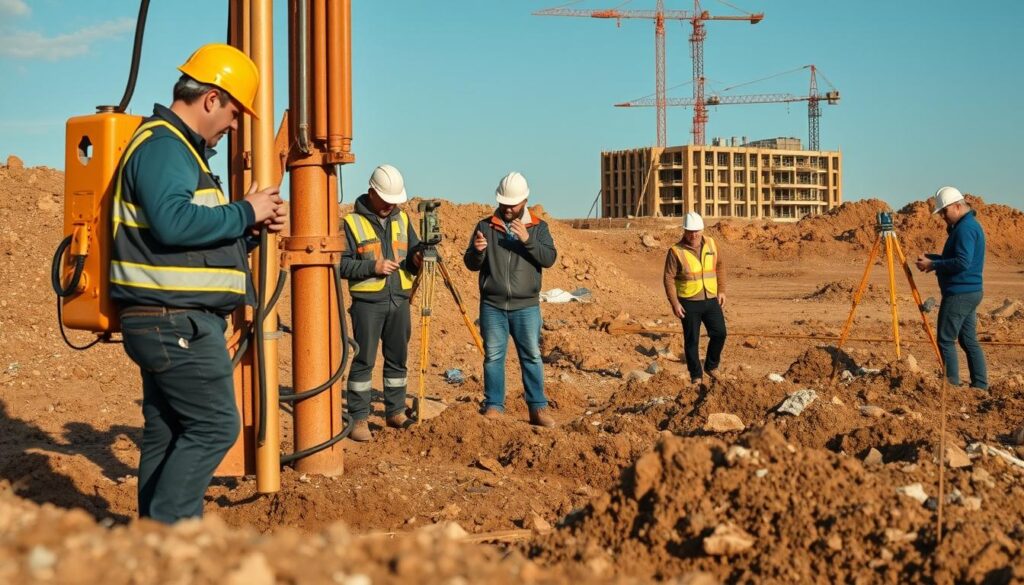
Compliance with Regulations
In addition to risk mitigation, geotechnical investigations are also essential for compliance with regulatory requirements. Many jurisdictions have strict regulations governing construction practices, and geotechnical investigations provide the necessary data to ensure that these regulations are met.
- Regulatory compliance assessment
- Geotechnical data collection and analysis
- Reporting and documentation
By conducting thorough geotechnical investigations, project developers can demonstrate their commitment to safety, environmental protection, and regulatory compliance, thereby reducing the risk of legal and financial repercussions.
Types of Geotechnical Investigations
Various techniques are employed in geotechnical investigations to assess site conditions. These investigations are critical for gathering data that will inform the design and construction phases of a project.
Preliminary Site Assessments
Preliminary site assessments are the initial step in understanding the geotechnical conditions of a site. These assessments typically involve a review of existing data, such as geological maps and previous investigation reports, to identify potential hazards and subsurface conditions.
Key components of preliminary site assessments include:
- Review of historical data and geological maps
- Site reconnaissance to observe surface conditions
- Initial evaluation of potential geotechnical risks
Subsurface Exploration Techniques
Subsurface exploration techniques are used to gather detailed information about the subsurface conditions at a site. Geotechnical drilling is a common method used to collect soil and rock samples for further analysis.
Some of the subsurface exploration techniques include:
- Drilling boreholes to collect samples
- Conducting in-situ tests, such as Standard Penetration Tests (SPT) and Cone Penetration Tests (CPT)
- Sampling using techniques like rotary drilling and sampling
Laboratory Testing Methods
Laboratory testing is a crucial phase of geotechnical investigations, where the samples collected during subsurface exploration are analyzed to determine their physical and mechanical properties. Soil testing and laboratory testing are essential for understanding how the soil will behave under different conditions.
Laboratory tests may include:
- Classification tests to determine soil type and properties
- Strength tests, such as triaxial and unconfined compression tests
- Consolidation tests to assess settlement characteristics
By combining preliminary site assessments, subsurface exploration techniques, and laboratory testing methods, geotechnical investigations provide a comprehensive understanding of site conditions, enabling more informed decision-making in construction projects.
The Geotechnical Investigation Process
Understanding the geotechnical investigation process is vital for ensuring the stability and safety of construction projects. This process is multifaceted, involving several key steps that collectively contribute to a comprehensive understanding of the site conditions.
Planning and Preparation
The initial phase of the geotechnical investigation process is planning and preparation. This stage involves defining the objectives of the investigation, selecting appropriate methods for data collection, and determining the equipment needed. Effective planning is crucial for ensuring that the investigation is conducted efficiently and that the data collected is relevant and useful.
During this phase, geotechnical engineers review existing data on the site, including geological maps and previous investigation reports. They also consult with stakeholders to understand the project’s requirements and constraints.
Field Investigation Phase
The field investigation phase is where data collection occurs. Techniques used can include drilling boreholes, conducting in-situ tests, and collecting soil and rock samples. The quality of the data collected during this phase is paramount to the success of the overall investigation.
Various tools and equipment are utilized during the field investigation, including drilling rigs and sampling equipment. The choice of equipment depends on the site conditions and the objectives of the investigation.
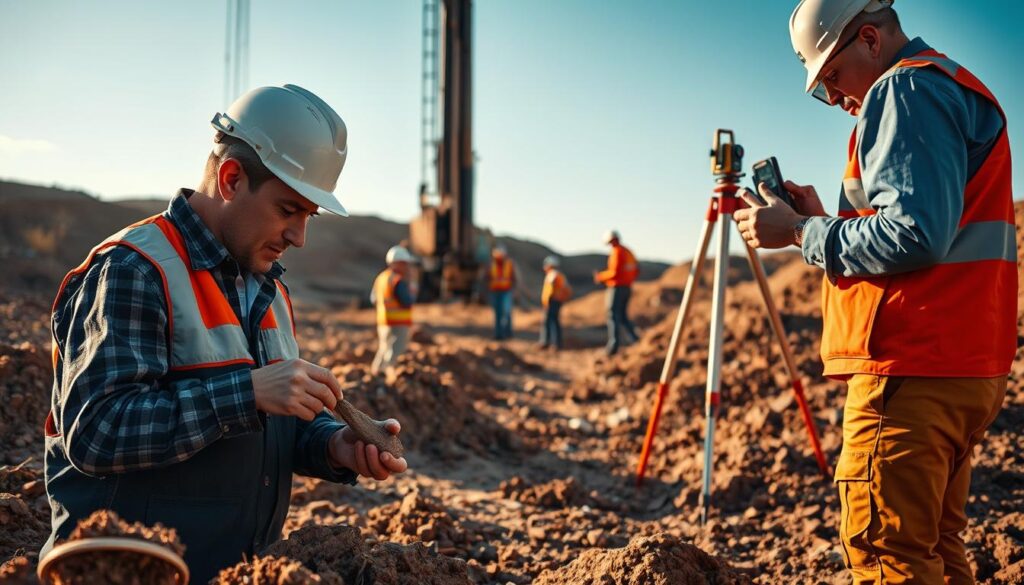
Data Analysis and Reporting
After data collection, the next critical step is data analysis and reporting. Geotechnical engineers analyze the data collected during the field investigation to identify key trends and patterns. This analysis informs the development of a comprehensive geotechnical report.
The geotechnical report presents the findings of the investigation, including any recommendations for design or construction modifications based on the site conditions. A well-prepared report is essential for ensuring that project stakeholders have the information needed to make informed decisions.
| Phase | Key Activities | Outcomes |
|---|---|---|
| Planning and Preparation | Defining objectives, selecting methods, reviewing existing data | Clear investigation plan |
| Field Investigation | Drilling, sampling, in-situ testing | Data on subsurface conditions |
| Data Analysis and Reporting | Analyzing data, preparing geotechnical report | Comprehensive report with recommendations |
Tools and Equipment Used
Effective geotechnical investigations require the use of sophisticated drilling rigs and soil testing equipment. These tools are essential for gathering accurate data about subsurface conditions, which is critical for the success of any construction or infrastructure project.
Drilling Rigs and Tools
Drilling rigs are a crucial component of geotechnical investigations, used to extract soil and rock samples from beneath the surface. For more information on the types of geotechnical instrumentation used in monitoring applications, you can visit ECS Limited.
The choice of drilling rig depends on the type of project, the depth of investigation required, and the nature of the subsurface materials. Different types of drilling rigs are suited for various soil and rock conditions.
| Rig Type | Application | Soil/Rock Type |
|---|---|---|
| Rotary Drilling Rig | Deep investigations, hard rock | Rock, hard soil |
| Auger Drilling Rig | Shallow investigations, soft soil | Soft soil, clay |
| Percussion Drilling Rig | Hard soil, mixed ground conditions | Mixed soil, gravel |
Soil Testing Equipment
Soil testing equipment is used to assess the physical and mechanical properties of soil samples obtained during drilling operations. This equipment includes devices for measuring soil density, moisture content, and shear strength.
Some common types of soil testing equipment include:
- Triaxial testing apparatus for assessing soil shear strength under different stress conditions.
- Consolidation test equipment for evaluating soil settlement characteristics.
- Direct shear test apparatus for determining soil shear strength.
Using the right soil testing equipment is crucial for obtaining accurate and reliable data, which in turn informs the design and construction process.
Key Considerations for Site Selection
When it comes to choosing a construction site, several key considerations must be taken into account to avoid potential pitfalls. The process involves a comprehensive evaluation of various factors that can impact the project’s success.
Local Geology and Soil Types
Understanding the local geology and soil types is crucial for site characterization. Different geological formations and soil types can significantly affect the stability and safety of the construction project. For instance, areas with soft or expansive soils may require specialized foundation designs to mitigate potential risks.
A thorough site investigation, including subsurface exploration and laboratory testing, can provide valuable insights into the site’s geological conditions. This information is essential for designing appropriate foundations and other structural elements.
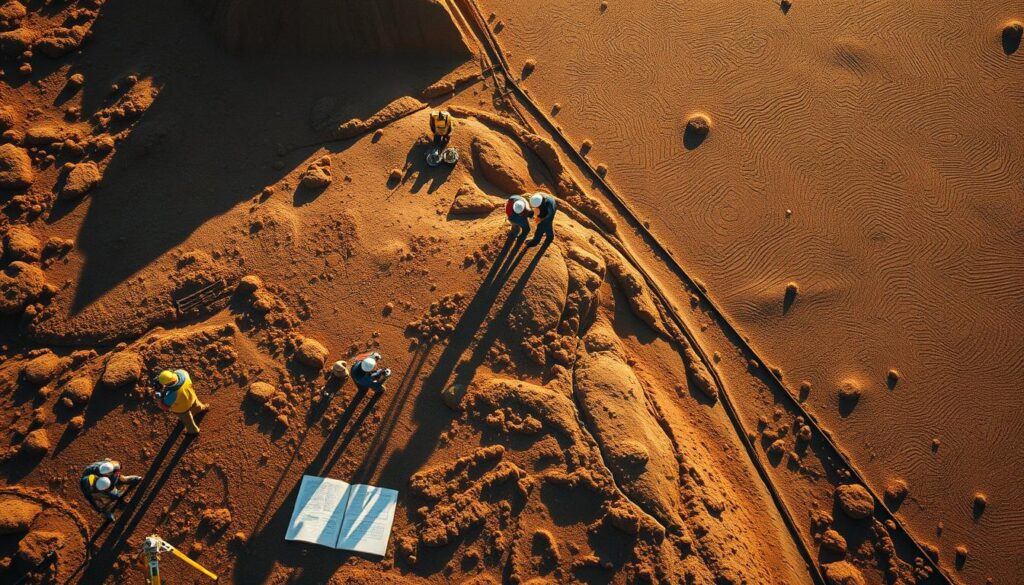
Environmental Impact Assessments
Environmental impact assessments play a vital role in identifying potential ecological risks associated with the project. These assessments help in understanding the potential effects on local ecosystems, water resources, and air quality.
Conducting an environmental impact assessment involves evaluating various factors, including the site’s biodiversity, water sources, and potential for pollution. By identifying potential environmental risks early on, developers can implement strategies to mitigate these impacts and ensure compliance with environmental regulations.
| Assessment Factor | Description | Potential Impact |
|---|---|---|
| Biodiversity | Evaluation of local wildlife and ecosystems | Habitat disruption, loss of species |
| Water Resources | Assessment of nearby water sources | Water pollution, depletion of resources |
| Air Quality | Monitoring of air pollutants | Air pollution, health risks |
For more detailed information on geotechnical investigations, you can refer to this comprehensive guide.
Role of Geotechnical Engineers
The success of construction projects heavily relies on the expertise of geotechnical engineers. Their role is multifaceted, involving a deep understanding of soil mechanics, geotechnical engineering principles, and the ability to collaborate with other professionals.
Skills and Expertise Required
Geotechnical engineers must possess a unique blend of skills and knowledge. They need a strong foundation in soil mechanics and geotechnical engineering principles to analyze soil conditions and predict potential issues. As noted by a renowned expert, “A thorough understanding of soil behavior is crucial for designing safe and efficient foundations.”
“The soil is the most complex and unpredictable element in any construction project.”
Their expertise extends to using advanced software and technologies for site investigation and analysis. They must be adept at interpreting data from field investigations and laboratory tests to inform design decisions.
Collaboration with Other Professionals
Effective collaboration is key to the success of geotechnical engineers. They work closely with structural engineers and architects to ensure that their findings are integrated into the overall project design. This collaboration is essential for identifying potential risks and developing mitigation strategies.
Through their collaborative efforts, geotechnical engineers help to ensure that construction projects are executed safely and efficiently. As construction projects become increasingly complex, the role of geotechnical engineers will continue to evolve, incorporating new technologies and methodologies to meet emerging challenges.
Challenges in Geotechnical Investigations
Conducting geotechnical investigations can be fraught with difficulties, from unforeseen soil conditions to logistical hurdles. These challenges can significantly impact the success and timeline of a project.
Unforeseen Soil Conditions
One of the primary challenges in geotechnical investigations is encountering unforeseen soil conditions. These unexpected conditions can lead to delays and increased costs if not properly managed. For instance, discovering soft soil or expansive clays can necessitate significant design changes or additional foundation work.
To mitigate these risks, geotechnical engineers employ advanced technologies such as ground-penetrating radar and cone penetration tests. These tools help in better understanding the subsurface conditions, thereby reducing the likelihood of unexpected surprises during construction.
Weather and Site Accessibility Issues
Weather conditions and site accessibility are other significant challenges faced during geotechnical investigations. Inclement weather, such as heavy rain or snow, can hinder fieldwork, while difficult site access can complicate the deployment of drilling equipment and sampling.
Effective planning and contingency strategies are crucial in overcoming these challenges. This includes scheduling fieldwork during favorable weather conditions when possible and utilizing equipment that can handle adverse site conditions. For more insights on managing such challenges, visit Willmer Engineering’s article on geotechnical engineering challenges and.
| Challenge | Description | Mitigation Strategy |
|---|---|---|
| Unforeseen Soil Conditions | Unexpected soil types or properties | Advanced subsurface exploration techniques |
| Weather Conditions | Inclement weather affecting fieldwork | Scheduling work during favorable weather |
| Site Accessibility Issues | Difficulties in accessing the site | Utilizing adaptable equipment and planning alternative access routes |
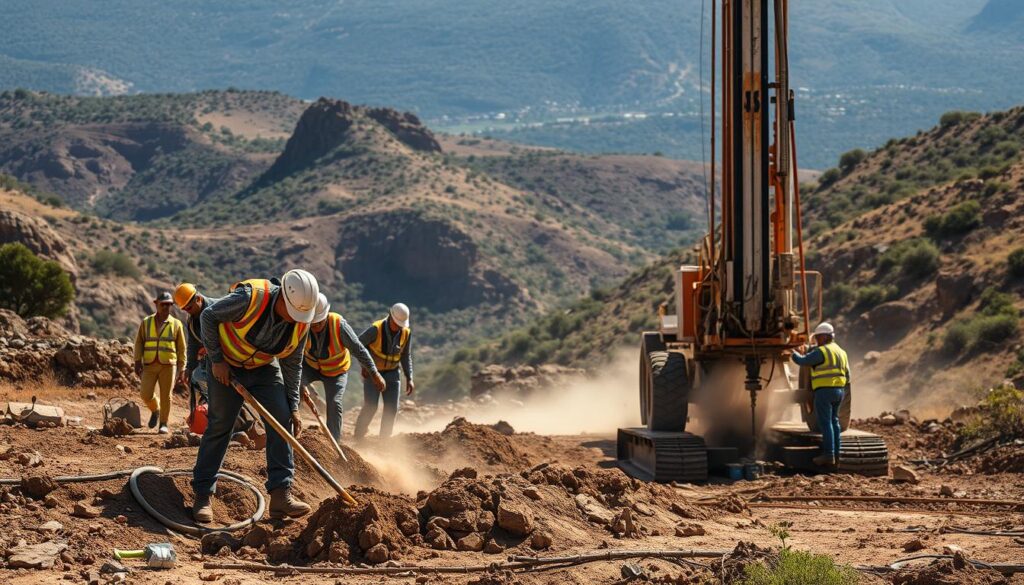
By understanding and addressing these challenges, geotechnical engineers can ensure more successful and efficient investigations, ultimately contributing to the overall success of construction projects.
Case Studies in Successful Investigations
The significance of thorough geotechnical investigations is evident in case studies of major projects and their achievements. By examining these real-world examples, we can gain a deeper understanding of the practices that contribute to successful outcomes.
Major Projects and Achievements
Several notable projects demonstrate the importance of comprehensive geotechnical investigations. For instance, the construction of the Channel Tunnel between England and France required meticulous geotechnical analysis to navigate complex geological conditions. The success of this project was largely due to the detailed site investigation, which allowed engineers to anticipate and mitigate potential issues.
Another example is the Burj Khalifa in Dubai, the tallest building in the world. Geotechnical investigations played a crucial role in its design and construction, particularly in understanding the soil conditions and foundation requirements. The thorough investigation enabled the design of a foundation system that could support the massive structure, ensuring its stability and safety.
Lessons Learned from Failures
While many projects achieve success through thorough geotechnical investigations, others have faced challenges due to unforeseen conditions or inadequate site assessments. Analyzing these failures provides valuable lessons for improving future practices.
For example, the Leaning Tower of Pisa is a historical case where inadequate understanding of soil conditions led to significant structural issues. The tower’s tilt was a result of the soft ground it was built on, and the lack of sufficient geotechnical investigation at the time contributed to the problem. Modern geotechnical practices have learned from such historical cases, emphasizing the importance of comprehensive site investigations.
By studying both successful projects and those that have encountered difficulties, geotechnical engineers can refine their methods and improve the outcomes of future investigations. This continuous learning process is essential for advancing the field and ensuring the success of complex projects.
Cost Factors in Geotechnical Site Investigation
While geotechnical investigations represent an upfront cost, they can lead to significant long-term financial benefits. Understanding the cost factors involved is crucial for effective budgeting and ensuring the success of your project.
Budgeting for Investigations
Budgeting for geotechnical investigations involves considering several key factors, including the type and complexity of the investigation, the size of the site, and the equipment and personnel required. It’s essential to work with experienced geotechnical professionals who can provide a detailed estimate of the costs involved.
Key cost components to consider include:
- Drilling and sampling costs
- Laboratory testing fees
- Equipment rental and maintenance
- Personnel and expertise costs
Long-term Financial Benefits
Investing in thorough geotechnical investigations can lead to substantial long-term financial benefits. By identifying potential issues early, you can avoid costly surprises during construction, reduce the risk of project delays, and minimize the need for expensive redesigns or repairs.
The financial benefits can be significant:
- Reduced construction costs through optimized design
- Minimized risk of costly delays and change orders
- Lower maintenance and repair costs over the project’s lifespan
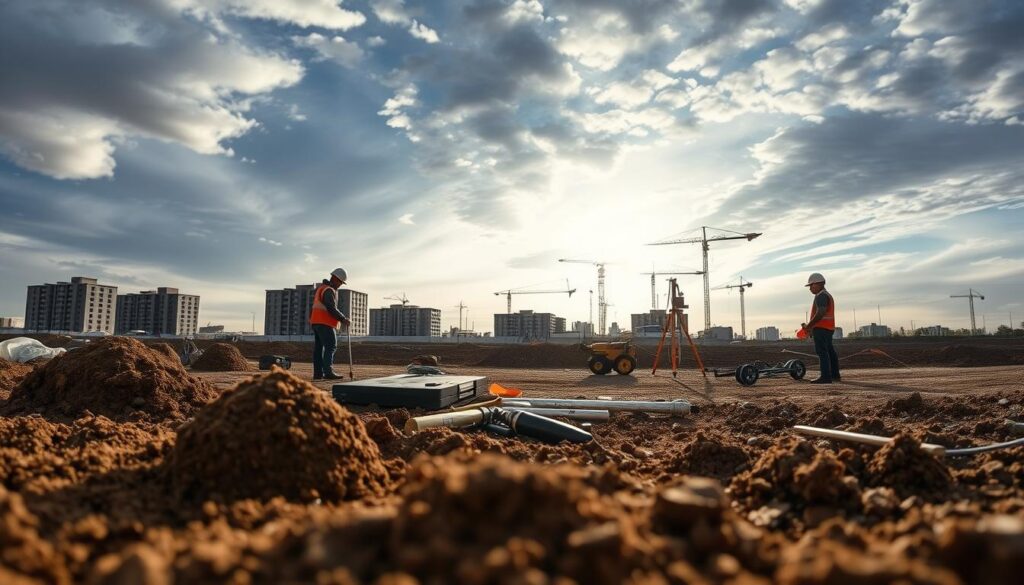
By understanding and budgeting for the costs associated with geotechnical site investigations, you can ensure that your project is well-planned, financially sound, and positioned for long-term success.
Choosing the Right Geotechnical Consultant
To ensure the success of your project, it’s essential to choose a geotechnical consultant with the appropriate qualifications and experience. A geotechnical consultant plays a pivotal role in assessing the ground conditions that can affect the design and construction of your project.
Qualifications and Experience to Look For
When selecting a geotechnical consultant, there are several key factors to consider. First and foremost, they should have the necessary professional certifications and a strong educational background in geotechnical engineering or a related field.
Experience is also crucial. Look for consultants who have worked on projects similar to yours, as they will be more familiar with the specific challenges you may face. For instance, a consultant with experience in seismic hazard assessments can provide valuable insights if your project is located in an earthquake-prone area.
| Qualification | Description | Importance Level |
|---|---|---|
| Professional Certifications | Certifications from recognized bodies such as PE (Professional Engineer) | High |
| Educational Background | Degree in Geotechnical Engineering or related fields | High |
| Project Experience | Experience in handling similar projects | High |
Questions to Ask During Selection
During the selection process, it’s vital to ask the right questions to gauge the consultant’s suitability for your project. Some of the key questions to ask include:
- Can you share examples of previous projects you’ve worked on?
- What methodologies do you use for geotechnical investigations?
- How do you stay updated with the latest technologies and practices in geotechnical engineering?
For more detailed guidance on selecting a geotechnical expert, you can refer to this comprehensive guide.
“The right geotechnical consultant can significantly reduce the risk of unforeseen ground conditions, thereby saving time and costs in the long run.”
By carefully evaluating the qualifications and experience of potential geotechnical consultants and asking the right questions, you can ensure that your project is in capable hands.
Future Trends in Geotechnical Investigations
The geotechnical investigation landscape is rapidly evolving, driven by technological advancements and a heightened focus on sustainability. As the industry moves forward, it’s crucial to understand the trends that will shape the future of geotechnical investigations.
Advances in Technology
Technological innovations are revolutionizing geotechnical investigations. Improved drilling techniques and advanced data analysis software are enhancing the accuracy and efficiency of site investigations. For instance, the use of real-time data monitoring systems allows for more precise and timely data collection, reducing the risk of unforeseen site conditions.
Moreover, the integration of artificial intelligence (AI) and machine learning (ML) in geotechnical investigations is opening new avenues for data analysis and interpretation. These technologies enable the identification of complex patterns in data, leading to more informed decision-making.
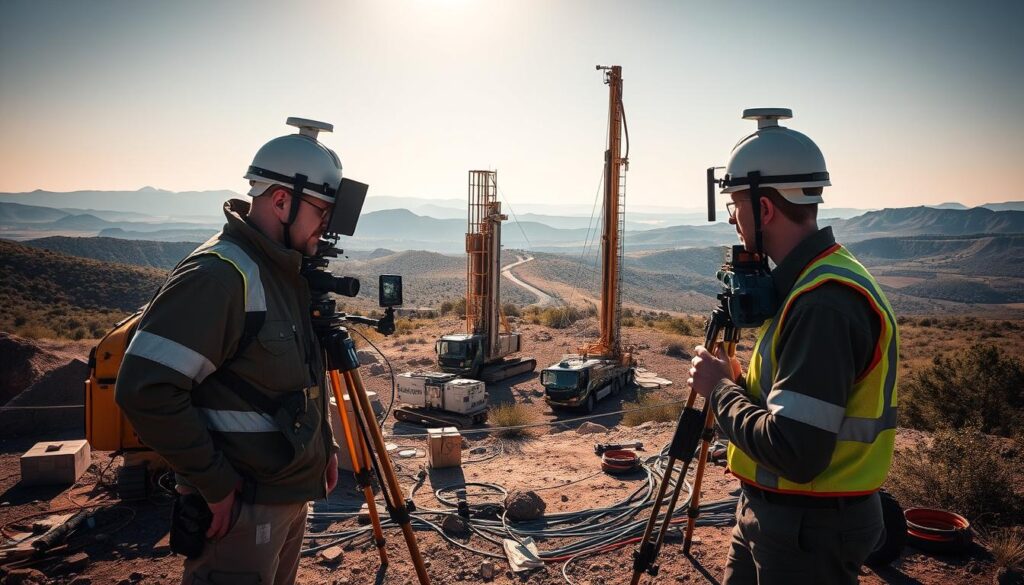
Sustainable Practices and Innovations
Sustainability is becoming increasingly important in geotechnical investigations. The industry is shifting towards eco-friendly practices and sustainable materials, reducing the environmental footprint of investigative processes. This includes the use of recycled materials in drilling and sampling equipment.
Furthermore, innovations in geotechnical engineering are focusing on minimizing environmental impact while maximizing project efficiency. For example, recent trends in site investigation highlight the importance of sustainable practices in geotechnical testing.
As the field continues to evolve, embracing both technological advancements and sustainable practices will be key to successful geotechnical investigations. By staying informed about these future trends, professionals can ensure that their projects are both efficient and environmentally responsible.
The Impact of Geotechnical Findings on Design
Geotechnical investigations provide critical data that impacts the overall design and safety of construction projects. The findings from these investigations are essential for ensuring that structures are not only stable but also cost-effective.
The data collected during geotechnical investigations informs various aspects of structural design. For instance, understanding the soil type and its properties is crucial for designing foundations that can support the weight of the structure. According to a study on the role of geotechnical engineering, the findings from site investigations significantly influence foundation design and soil stabilization techniques.
Influence on Structural Design
Geotechnical findings have a direct impact on the structural design of a project. The information gathered about the subsurface conditions helps engineers design structures that are adapted to the specific site conditions. This includes determining the appropriate depth and type of foundations, as well as designing retaining structures and other earthworks.
Key factors influenced by geotechnical findings include:
- Foundation type and depth
- Design of retaining structures
- Soil stabilization techniques
- Pavement design for roads and highways
Adjustments and Modifications to Plans
Based on the geotechnical findings, project plans often require adjustments to ensure that the structure is safe and feasible. These adjustments can range from modifying the foundation design to changing the layout of the project to better suit the site conditions.
For example, if the geotechnical investigation reveals poor soil conditions, the project might require additional soil stabilization measures or a different foundation design. The following table illustrates some common adjustments made based on geotechnical findings:
| Geotechnical Finding | Potential Adjustment |
|---|---|
| Poor soil conditions | Soil stabilization or alternative foundation design |
| High water table | Design modifications to prevent water ingress |
| Unstable slopes | Implementation of retaining structures or slope stabilization techniques |
In conclusion, geotechnical findings play a vital role in shaping the design of construction projects. By understanding the subsurface conditions and making informed decisions, engineers can ensure that structures are both safe and cost-effective.
Summary: The Foundation of Successful Projects
Geotechnical site investigations are fundamental to the success of construction projects, providing critical information about subsurface conditions that can impact design and execution.
The key points discussed throughout this article highlight the significance of geotechnical investigations in risk mitigation, compliance with regulations, and informed decision-making. By understanding the subsurface conditions, project stakeholders can make adjustments to their plans, ensuring a more stable and secure foundation for their projects.
Recap of Main Takeaways
The main takeaways from this discussion include the importance of preliminary site assessments, subsurface exploration techniques, and laboratory testing methods. These components work together to provide a comprehensive understanding of the site conditions.
Final Thoughts
In conclusion, the importance of geotechnical site investigations cannot be overstated. By investing in thorough investigations, project stakeholders can avoid costly surprises, ensure compliance with regulations, and ultimately lay the foundation for successful projects. The summary of key points underscores the value of these investigations in achieving project goals.
